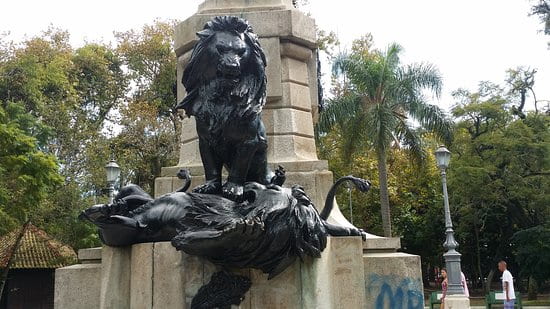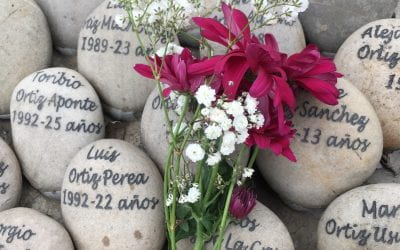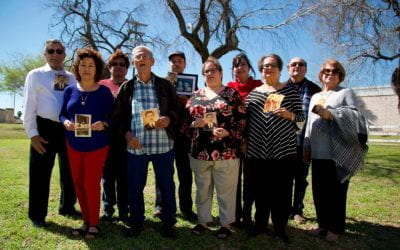Brazil’s Huge Past Ahead
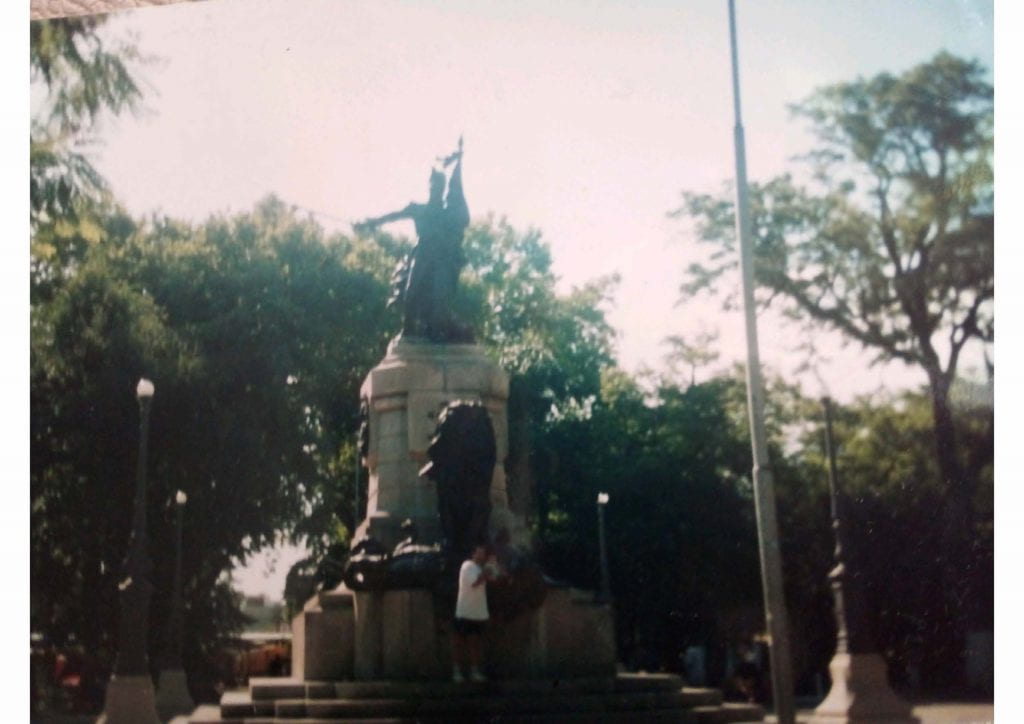
“The author as a child in a faded photo of the statue in Praça Tamandaré, RS, Brazil
I still recall the two lions imposingly fighting. One stands still on top of the other, with its two legs on its enemy’s chest. The other roars back, and has its claws ready to fight.
“Can I take a picture on his paw?” I ask my father on one of our weekly outings to Praça Tamandaré, the center of urban life in my hometown of Rio Grande, Brazil.
Sitting on the lion’s paw, like my parents and many other generations did before me for the past century as part of a local tradition, the five-year-old me had no clue what the true meaning of that statue was. And for much of my life, I would continue to be clueless about it.
The rebellious lion, I later learned, is a metaphor for the rebellious state I grew up in, which between 1835 and 1845 engaged in a 10-year war to secede from Brazil. The winning beast represents the triumphant federal government. The most important part of that colossal artwork, however, beyond the lions: They guard not only a statue of Bento Gonçalves, the revolt’s leader, but also his remains.
Gonçalves has been buried in Rio Grande, a port city of nearly 200,000 in Brazil’s southernmost state of Rio Grande do Sul, since 1909. Gonçalves, who died in 1847, had his remains moved to my hometown after the city won a statewide contest to host the local hero.
Inspired by the French Revolution’s ideals, the general led his troops against the Brazilian government in protest of federal taxation and lack of autonomy. On September 20, 1835, Gonçalves and his men—mostly wealthy landowners, but with the support of many other sectors of society—declared war on Brazil, igniting the Guerra Farroupilha (Ragamuffin War). A year later, the revolutionaries seceded from Brazil, declaring the establishment of the Rio-Grandense Republic. Gonçalves was appointed president by his fellow revolutionaries.
Despite eventually losing the war, the revolt’s ideals have remained in place for many in Rio Grande do Sul. The state’s flag still reads “Rio-Grandense Republic.” September 20 is a holiday in the state. And many, including some in my family, casually describe themselves as having “ragamuffin blood.”
But some, including Black activists and historians, say the war and its ideals were surrounded by controversy. In Brazil’s second whitest state, Gonçalves and his ragamuffins also represented the anti-Blackness sentiment that was socially acceptable back then but that persists nowadays.
During the war, one of Golçalves’ pro-abolition colleagues, Antônio de Souza Netto, suggested the leaders freed enslaved people so that they could join the revolution. The leadership did not agree on that until 1836, when many of their men died in a battle. For the next decade, the formerly enslaved fighters, known as Black Lancers, fought alongside their white counterparts.
As the end of the war approached and the two sides engaged in peace discussions, freedom for Black soldiers—which by then had become a Ragamuffin ideal—was seen as a non-negotiable demand. Some of the wealthy landowners behind the revolt, however, did not agree with this ideal.
This is why some historians argue that two enemy generals, Ragamuffin David Canabarro and the Duke of Caxias, with the Brazilian Crown, lured the Black soldiers into a trap. In November 1844, Canabarro deployed the Black Lancers without any ammunition to fight a much larger number of pro-crown soldiers. On the letter that ordered the deployment of federal troops, the duke told one of his commanders to “spare the Brazilian blood, especially that of white people.” As a result, it is estimated that between 170 and 800 people died in what today’s known as the Porongo Massacre. Those who survived were reportedly taken to Rio de Janeiro, where they were enslaved again.
Although Gonçalves was not part of the set-up, some reports say he owned slaves at the time of his peaceful death. That, of course, is still not well-known by the many who come across his statue, protected by the two fighting beasts, daily in Rio Grande.
And the anti-Black legacy of the allegedly liberal movement can still be seen nowadays. “The 20th of September was the precursor of liberty,” goes the state’s anthem. A few verses later comes a controversial line that these days sparks discussion, “The people who do not have virtue end up being slaves.”
While for many years the Porongo Massacre was an unknown history, statues of Gonçalves, as well as other important figures from that period—including Canabarro and the Duke of Caxias, who later became the Brazilian military’s patron— were erected one after the other across the state.
But as conversations around the removal of controversial statues have arisen around the world, some wondered what would happen to those similar to Gonçalves’.
In the wake of the toppling of statues across the United States and Europe last year, Jeremy Adelman, the director of the Global History Lab at Princeton University, told me that if we were to see a discussion around Latin America’s dark past, it would likely be around modern-era dictatorships, and not colonization.
“Reckoning with dictatorships is a more proximate memory,” he told me, citing Brazil as an example. “If we’re going to see a public fight over memory, it’s going to be around that. But there are no statues to be taken down, so it will take a different form.”
- Monument Bento Golçalves, Praça Tamandaré, RS, Brazil (TripAdvisor).
- Statue of “Rebellious Lions” Praça Tamandaré, RS, Brazil (TripAdvisor).
Adelman is right. It is unfair to compare the amount of monuments that pay tribute to dictators and other controversial figures in Brazil to the number of streets, bridges, schools and other public spaces that take their names. In addition to the one in my hometown, Gonçalves himself has a few other monuments dedicated to him spread throughout Rio Grande do Sul. But in absolute terms, that cannot be compared to the number of avenues, soccer clubs and even the city of 120,000 that take his name.
Despite the difference, the truth is that neither the conversation on toppling statues nor the one on renaming public spaces have picked up in Brazil—unlike in some of its South American neighbors. In Chile, Indigenous groups took down the statue of Spanish conquistador Pedro de Valdívia in 2019. In Argentina, as early as 2013, a monument to Christopher Columbus was removed from the front of the country’s presidential palace and later relocated to a much less glamorous venue.
The closest Brazil has gotten on that front was when two monuments to bandeirantes, groups of fortune hustlers from the colonial era who often hunted down and enslaved Indigenous people in the Brazilian countryside, appeared spray painted in 2016. So far, no statues have been removed countrywide.
On the name-changing front, Brazil seems to have taken more effective steps. Throughout the country, different groups have fought to change street names tied to the dictatorship. The city of São Paulo established in 2015 an urban planning program that aims to “change progressively and in a participative way the name of streets that pay homage to human rights violators from the military dictatorship era.” So far, the initiative has renamed more than 20 public spaces, including a 2.2-mile elevated highway that had its name changed from a dictator’s name to that of the last democratic president before the dictatorship, João Goulart, or Jango.
The country, however, still has a long way to go. At least 197 streets, bridges and viaducts continue to be named after the dictatorship’s presidents, according to the memory education project Ditamapa. Another investigation by the journalism agency Agência Pública concluded that there are nearly 2,900 kilometers (1,801 miles) of streets that pay tribute to dictators in Brazil, while those honoring the dictatorship’s victims encompass only around 164 kilometers (100 miles).
Again, Brazil could learn one thing or two from its neighbors on the collective memory front. Unlike other South American countries that have also endured dictatorships, like Argentina and Chile, it took Brazil 26 years to establish a truth commission to investigate the violations that took place during the country’s 20-year-long regime
Emerging from a civil-military dictatorship that cost nearly 9,000 lives in 1983, Argentina’s democratic leaders were assertive in guaranteeing the pro-dictatorship sentiment did not survive the transition process. The “Nunca Más” report, produced by the country’s truth commission and published a year after the end of the dictatorship, described in detail the violence committed against thousands of Argentines during the seven-year-long regime—including the torturing of women and the kidnapping of at least 500 newborns.
While the report paved the way for the construction of a collective memory that discourages any sympathy toward dictators, in Brazil it took the government 26 years to establish a truth commission to investigate the violations that took place during the 20-year-long dictatorship.
In Argentina, as of 2017, more than 800 people tied to the military had been condemned for and around 750 accused of human rights violations committed during the Argentine dictatorship. Due to the 1979 Amnesty Law that pardoned those involved on both sides of the struggle, and consequently legalized impunity, the first time the Brazilian justice system condemned a regime agent for a political crime committed during the dictatorship was this June.
The lack of collective memory, combined with decades of impunity, has allowed for official displays of a pro-dictatorship sentiment. Brazilian President Jair Bolsonaro, who ran on a military regime-friendly platform, has repeatedly shown his support for well-known torturers and has even attended pro-military intervention protests.
Many Brazilians think similarly to their commander-in-chief. As of June 2020, one in 10 Brazilians would be in favor of a military regime. On the occasion, only three-quarters of them actively supported a democratic government, according to the polling institute Datafolha.
That, in part, has to do with the lack of public knowledge of the atrocities committed during the last military dictatorship, combined with the indirect worshiping of military leaders through public symbols named after them. Brazilian historian Reginaldo Benedito Dias once wrote that to name public spaces after someone is the same as choosing a character or fact “to become perennial in the collective history.”
Pretty much anywhere in Brazil, from the million-people urban centers to the small towns in the Amazon and the Cerrado, it is easy to find a street—likely a boulevard—named after Humberto de Alencar Castelo Branco or Eurico Gaspar Dutra, two of Brazil’s dictators. Many other streets, parks and schools pay tribute to lesser known Brazilians who were active in one way or another in the dictatorship. And then there are other tributes to slave traders and owners, bandeirantes or colonizers.
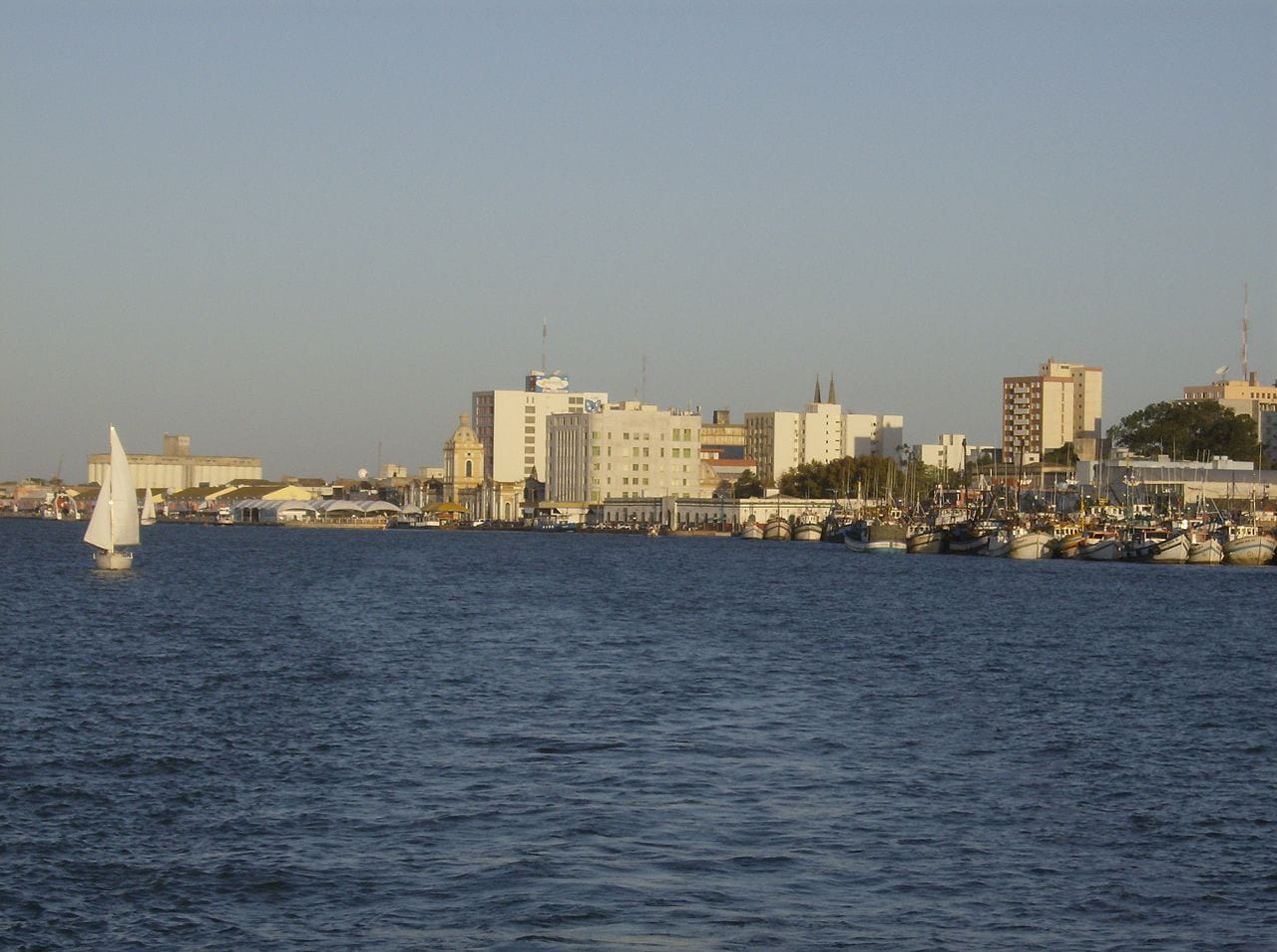
City of Rio Grande, State of Rio Grande do Sul, Brazil.
But similarly to that Golçalves statue in my hometown, many in Brazil may have incorporated these controversial symbols to their routine, not even considering what they could represent, or signify. As a child, when I looked at his statue, I focused on the two imposing lions, not on the controversial revolutionary that rests underneath them,
To create a collective consciousness that could eventually lead to a more aware collective history, Brazil needs to start a conversation that brings together different parts of society—not only the ones who have historically gotten to set the narrative. The process to understand and critically think about Brazil’s past starts at its educational system. In school, I was taught about Gonçalves and his accomplishments, but never about the Black Lancers. And in the public schools I attended, we never had enough time—or resources—to learn about the dictatorship, including textbooks and in-depth history classes.
I had the privilege to be offered additional opportunities to learn about my country’s troubled past. I first learned about it when I took classes like Terror Archives in Latin America—a course I left stunned to learn that places like Chile and Argentina, the memory of the dictatorship was explored and discussed in-depth. But in a place so unequal like Brazil, many cannot afford to do so. Similarly to street and school names, collective memory has been imposed on a large share of Brazilian society.
“Brazil has a huge past ahead,” Brazilian writer and cartoonist Millôr Fernandes, who had his work censored during the dictatorship, once wrote. To tackle this past, we better start with what is around us. The streets we walk in, the schools we go to and the bridges we cross on our way to work.
Spring/Summer 2021, Volume XX, Number 3
Related Articles
The Eye that Cries: Peru’s Unreconciled Memories
English + Español
In Lima, Peru, in the midst of Campo de Marte, a public park named after the god of war, a Zen space for reflection is guarded by a cast iron fence. El Ojo que Llora (“The Eye that Cries”…
Editor’s Letter: Monuments and Counter-Monuments
Cuba may be the only country on the planet that sports statues of John Lennon and Vladimir Lenin. Uruguay may be the first in planning a full-fledged monument to the victims of the Covid-19 pandemic.
A Monumental Battle for the Story of Texas
In 2016, I visited the Alamo, as part of my first real return to Texas in many years. I had mapped out a road trip with my brother Edmund Roberts. Though Edmund has long known of…


